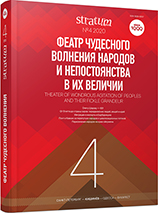Межэтнические взаимодействия и культурный синкретизм в раннесредневековом Гуюане (по материалам погребения с лаковым гробом эпохи Северная Вэй)
Inter-Ethnic Relations and Cultural Syncretism in Early Medieval Guyuan (based on the materials of the Northern Wei lacquer coffin tomb)
Author(s): Daniil Shulga, Maria Andreevna KudinovaSubject(s): History, Archaeology, Cultural history, Middle Ages, 6th to 12th Centuries, Migration Studies
Published by: Издательский дом Stratum, Университет «Высшая антропологическая школа»
Keywords: China; Guyuan; Northern Wei; Early Medieval period; Xianbei; cross-cultural contacts; funerary rite; Silk Road
Summary/Abstract: The monuments of the Silk Road as a complex cultural phenomenon are variously represented in the northwest China, that was caused by a number of factors. Firstly, a noticeable amount of Proto-Cninese huaxia had resided in this region since the Eastern Zhou epoch. Secondly, nomadic waves from Eurasian Steppe Belt (e. g. Xiongnu, Xianbei, etc.) reached this territory. Thirdly, the migrants from Central Asia (Sogdia, Bactria) and Western Asia were active in the described region too. This type of ethnocultural situation induced religious, political and cultural syncretism. The paper (for the first time in Russian-language academic literature) presents a detailed description of a “tomb with lacquer coffin” from Guyuan (Ningxia-Hui Autonomous Region, China) also providing a guidance on the historical background of this unique complex, which had absorbed Chinese, nomadic and Western Asian traditions.
Journal: Stratum plus. Археология и культурная антропология
- Issue Year: 2020
- Issue No: 4
- Page Range: 193-201
- Page Count: 9
- Language: Russian
- Content File-PDF

